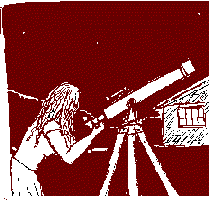The stars are free. Plain and simple. But, many of us have neither the means nor, how do I put this, the resources available to us to enjoy a true astronomical experience. In these pages, I will try to convey to the reader that all is not lost, that you can enjoy the sky as it was meant to be, free, or at least at a lower cost. In fact, you'd probably be amazed at just how easy it is to get into astronomy... inexpensively
If you just want to do basic stargazing, use just your eyes. For centuries, that's how it was done; the first telescopes weren't aimed skyward until the early 17th century. If you want to do a little more, the costs, obviously, is going go up. If you are willing (Willing being the operative term here) to invest a little sweat equity, it is far more cost effective to engineer and build a lot of your own equipment. Not to worry, this isn't as daunting as it might seem. If the desire is there, you can really go with this.
Astronomy, as a hobby, can be broken into different levels, as many endeavours can be. The level of your participation depends on you, but you do not have to confine yourself to one level. This is your hobby, and you get out of it what you want. The basic levels I've seen can be really broken down into three main categories; Stargazer, Amateur Hobbyist and Serious Hobbyist.

This is astronomy at its most basic. The only tools you need are your eyes, or maybe a small pair of binoculars. The Stargazer is one who goes out and looks at the sky itself, noting the postitions of the stars as the months and seasons progress. The Stargazer notes the relative positions of the Moon as it makes its monthly passage through the sky, and may even be adept enough to tell the month, date and time just by the rising and setting of certain objects. The Stargazer has no care for looking at Messier objects. Their thrill is in the sheer beauty of the heavens themselves. Binoculars may be used by the Stargazer to look at a few of the more interesting objects, such as the occasional comet, the Moon, a few nebulae and the brighter planets. Be they a dabbler or a true romantic, the Stargazer likes the simplicity of their chosen method enjoying the night.
 Here is where we start to find a greater level of investment, both of time and cost. The Amateur Hobbyist has telescopes, the prototypical
astronomer's tool. It might not be much, maybe a small 60mm refractor, but nothing larger than a 200mm reflector. The Amateur Hobbyist
spends hours looking at views that require a bit more magnification, such as planets and brighter deep sky objects. They probably take better
notes than the Stargazer, and may even have invested in astro-photographic equipment to show his friends and family the many wonders he has
seen. The Amateur Hobbyist sometimes visits star parties, maybe even undertaking a journey to get there. Other equipment may consist of
computer software, GPS and CCD imaging equipment.
Here is where we start to find a greater level of investment, both of time and cost. The Amateur Hobbyist has telescopes, the prototypical
astronomer's tool. It might not be much, maybe a small 60mm refractor, but nothing larger than a 200mm reflector. The Amateur Hobbyist
spends hours looking at views that require a bit more magnification, such as planets and brighter deep sky objects. They probably take better
notes than the Stargazer, and may even have invested in astro-photographic equipment to show his friends and family the many wonders he has
seen. The Amateur Hobbyist sometimes visits star parties, maybe even undertaking a journey to get there. Other equipment may consist of
computer software, GPS and CCD imaging equipment.
 This individual spends a lot of spare time behind, under or on top of their telescopes. And do they have telescopes; 200mm is NOT the limit
here. They have invested considerable effort into their love of astronomy. Many nights, the Serious Hobbyist may be found at a dark sky
location, looking for comets, watching asteroids occult stars, imaging the faintest galaxies. They may have written editorials or complete
articles, not just in the main publications but in obscure journals that cater to their specific interest. Many Serious Hobbyists have
specialties, choosing to concentrate their efforts in one area or another. To them, it has passed the realm of being a hobby, it is a calling.
(This page is STILL under construction! Sometimes, I wish I was cloned...)
This individual spends a lot of spare time behind, under or on top of their telescopes. And do they have telescopes; 200mm is NOT the limit
here. They have invested considerable effort into their love of astronomy. Many nights, the Serious Hobbyist may be found at a dark sky
location, looking for comets, watching asteroids occult stars, imaging the faintest galaxies. They may have written editorials or complete
articles, not just in the main publications but in obscure journals that cater to their specific interest. Many Serious Hobbyists have
specialties, choosing to concentrate their efforts in one area or another. To them, it has passed the realm of being a hobby, it is a calling.
(This page is STILL under construction! Sometimes, I wish I was cloned...)